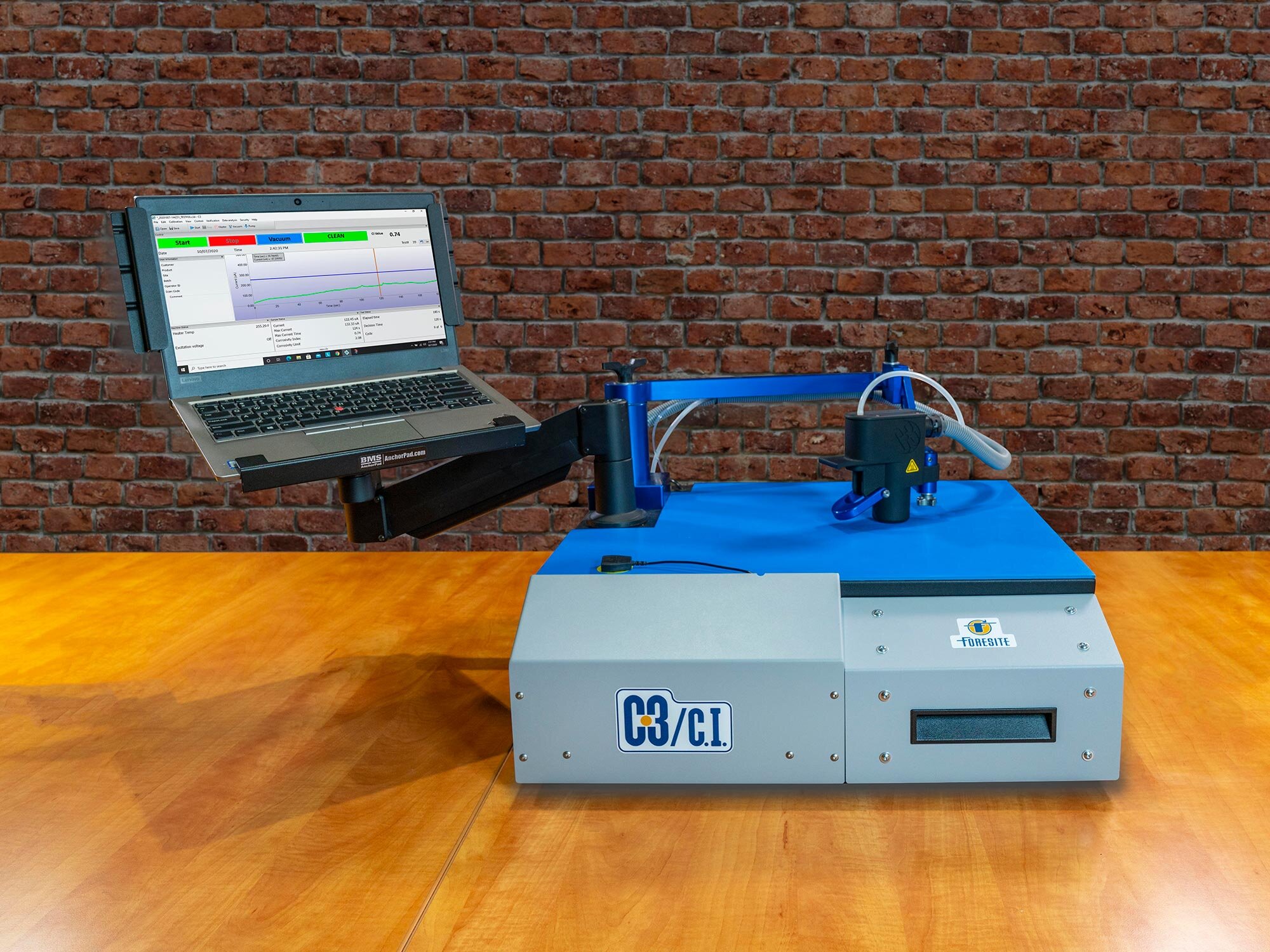Want to find out if your PCBAs are clean?
The Foresite C3 (Critical Cleanliness Control) is unique among electronics cleanliness testers – it remains the only tester on the market that indicates whether a specific, critical area of a PCBA is clean.

The C3 can provide immediate process monitoring data or even incoming material cleanliness assessment.
The C3/C.I. tracks the cleanliness of critical areas of your electronics over time with the Foresite C3 Corrosivity Index – a single test result that can be used to monitor and control manufacturing processes (and incoming component cleanliness).
The C3
Critical Cleanliness Control
The C3 has been designed to achieve effective ionic residue removal using a heated, extraction solution delivery system that consists of 3 stages: 1) Solution heating/delivery to the extraction site, 2) Soak and solubilization time, and 3) Aspiration of solution to collection cell.
The C3 extracts an approx. 2.2 mL sample into a collection cell. The sample can be used for other testing such as ion chromatography.
The single-use test cell is inserted into the steam head. At the completion of the test, the cell is removed from the head with the help of the ejector bar. The C3 test cell tests a 0.1 in2 area.
How the C3 works
Simply select the components and/or areas of circuitry that are most sensitive and prone to contamination-related performance and/or reliability issues and test an area that is 0.1 in2, or even smaller.
The C3 quickly provides feedback as to whether potentially detrimental residues, frequently from manufacturing processes, are present. The programmed test cycle is easily controlled with minimal training.
Extraction, Testing, or Both
The C3 can be used right in the electronics assembly area. In addition, product site-specific samples extracted by the C3 can be sent to a lab for analysis to identify the contaminants and measure their concentrations.
Areas to Test
Typical areas of extraction for process evaluation:
1st Side SMT Low Standoff Area
2nd Side SMT Low Standoff Area
Connector Leads from Selective Soldering
Open Holes and Vias with Kapton Tape
Board Area with No Active Circuitry
Additional Areas to Test
You can also use the C3 to test:
Incoming bare boards
Incoming components
Reworked component areas
Sites of visible corrosion
C3 Corrosivity Index™ (C.I.)
The C.I. is an indicator of the cleanliness of a test site analyzed by the C3. The index is calculated by dividing the maximum current seen during the test by the elapsed time of the test.
Using a programmable current limit setting of 250 µA and a decision time setting of 120 seconds, the C.I. limit is (250/120) 2.08.
A C3 test performed with these settings that reaches or exceeds 250 µA before 120 seconds has a C.I. greater than 2.08, resulting in a “dirty” indication. These test parameter settings (250 µA & 120 sec.) produce relatively sensitive C3 tests and are commonly used on higher reliability electronics (e.g. IPC Class II & III).
For the above test, C.I. = 250/95 = 2.63, a failed test.
The C.I. graph below shows the curve of C.I. values when the set current limit (250 µA) is reached, or exceeded, through the range of elapsed test times.
The “maximum” current used in a C.I. calculation is limited to the current set point (250 µA in these examples). The C3 test runs until the current exceeds the current set point (limit) or the total test time of 180 seconds is reached.
In this example, two samples pass the test in that the current limit is not reached by the decision time.
Another commonly used set of C3 test parameters is 500 µA and 60 seconds. These settings are used on electronics for less demanding applications and environments (e.g. IPC Class I). The C.I. limit when using these settings would be (500/60) 8.33.
The C3 Corrosivity Index provides a single test result value that can be plotted over time to track trending in product cleanliness – the lower the C.I. the less likely a tested product site will suffer performance problems due to the presence of a detrimental ionic residue.
Sample A (Blue Line): C.I. = 250/135 = 1.85
Sample B (Black Line): C.I. = 225/180 = 1.25
Testimonials
Request C3 Pricing or Information
To help us respond to your request as quickly as possible, please provide the following information:

















